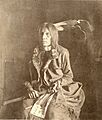Jaw (Ćehu′pa) facts for kids
Quick facts for kids
Jaw/Ćehu′pa, also known as His Fight/Oki’cize-ta’wa
|
|
|---|---|

Jaw (Ćehu′pa) or His Fight (Oki'cize-ta'wa) in 1913
|
|
| Born | c. 1850/1853 northern Great Plains, United States |
| Died | 22 July 1924 (aged 70–71) Standing Rock Indian Reservation, South Dakota, United States |
| Occupation | Winter count keeper, ledger art artist, warrior |
| Nationality | American, Lakota |
| Spouse | (1) Corn (Wa-hu-wa-pa), born ca. 1852, died before 1885; (2) Fear her Knife (Tamalakakipapi) born ca. 1851, died 25 November 1916 |
| Children | Killing of a White Buffalo (Pte-san-o-pi-win), Looks Behind (Ha-ki-kta-win) |
Jaw/Ćehu′pa, also known as His Fight/Oki’cize-ta’wa, was a brave Hunkpapa Lakota warrior. He was also a talented artist and a keeper of his people's history. He is known for his amazing Ledger art and for keeping a Winter count.
Jaw was born around 1850 or 1853 in the northern Great Plains of the United States. His father was from the Sans Arc Lakota group, and his mother was Hunkpapa Lakota. Both were parts of the free-roaming Teton Lakota. Jaw lost his mother when he was very young. His grandmother then raised him.
His childhood name was Ma'za-ho'waste, meaning "Loud-sounding Metal." When he was 17, he earned his true name, Oki'cize-ta'wa, or "His Fight." He received this name after his first experience in a real battle. He had already been known for being good at taking horses, but this was his first time fighting.
Jaw fought in the famous Battle of the Little Bighorn in 1876. After this, he went with the Lakota leader Sitting Bull to live in Canada for a while. He returned and surrendered to the United States in early 1881. Jaw then settled on the Standing Rock Indian Reservation, where he lived for the rest of his life.
Jaw's skills as a warrior made him famous among the Lakota people. He also became well-known to artists and people who studied cultures. In 1884, an American artist named DeCost Smith painted his portrait because of his achievements.
Jaw as an Artist and Historian
Jaw is especially known today because of Frances Densmore, a music ethnologist. She interviewed Jaw in 1911 and 1912. He shared many of his artworks with her.
Jaw was a very active artist. He created several ledger books, which are old accounting books used for drawing. One of his ledger books is now kept at the South Dakota State Historical Society. He is believed to be the main artist for the Macnider and the Amidon ledgers, both from around 1885.
The Amidon Ledger was found in 1985 in North Dakota. In 2016, before its drawings were sold separately, the ledger was scanned. Experts believe that 87 or more of the 107 drawings in it were made by Jaw.
Jaw was one of the most important Lakota experts on traditional life. When he worked with Frances Densmore, he was in his late fifties or early sixties. He sang songs about his life as a warrior. He also painted scenes on cloth showing his early life as a hunter, horse stealer, and healer.
Jaw shared his stories with other non-Native people too. Mary Collins was a missionary who worked on the Standing Rock Indian Reservation from 1885 to 1910. Her papers include drawings made on pages torn from a ledger book. Many of these drawings show the war and horse-stealing adventures of a man named Okicinintawa, which was another name for Jaw. These drawings show that he was part of the Lakota Miwa'tani Society, a group of warriors.
Family Life
Jaw was married at least two times. His first wife was named Corn (Wa-hu-wa-pa). She was born around 1852. They had two daughters, Killing of a White Buffalo (Pte-san-o-pi-win) and Looks Behind (Ha-ki-kta-win). His daughters were likely born while the family was living in Canada.
It seems his first wife and daughters died soon after they moved to the Standing Rock Agency. By 1885, Jaw had a new wife named Fear her Knife (Tamalakakipapi). She was born around 1851. Jaw passed away on July 22, 1924.
Images for kids




